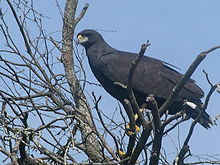It has been suggested that Harpyhaliaetus be merged into this article. (Discuss) Proposed since July 2024. |
| Buteogallus Temporal range: Middle Miocene to present
| |
|---|---|

| |
| Great black hawk (Buteogallus urubitinga) | |
| Scientific classification | |
| Domain: | Eukaryota |
| Kingdom: | Animalia |
| Phylum: | Chordata |
| Class: | Aves |
| Order: | Accipitriformes |
| Family: | Accipitridae |
| Subfamily: | Buteoninae |
| Genus: | Buteogallus Lesson, RP, 1830 |
| Type species | |
| Buteogallus cathartoides[1] = Falco aequinoctialis Lesson, 1830
| |
| Species | |
|
see text | |
| Synonyms | |
|
Alectromorphnus Heine & Reichenow, [1890] | |
Buteogallus is a genus of birds of prey in the family Accipitridae. All members of this genus are essentially neotropical, but the distribution of a single species extends slightly into the extreme southwestern United States. Many of the species are fond of large crustaceans and even patrol long stretches of shore or riverbank on foot where such prey abounds, but some have a rather different lifestyle. Unlike many other genera of raptor, some members are referred to as "hawks", and others as "eagles".
Most of the species have a characteristic tail pattern. This consists of a black base, a wide white middle band, a wide black band, and a quite narrow white band on the feathertips that is often hard to discern or may be lost when the feathers are very worn. Only the white-necked hawk and the rufous crab hawk have a very different tail patterns (see also below).
- ^ "Accipitridae". aviansystematics.org. The Trust for Avian Systematics. Retrieved 26 July 2023.